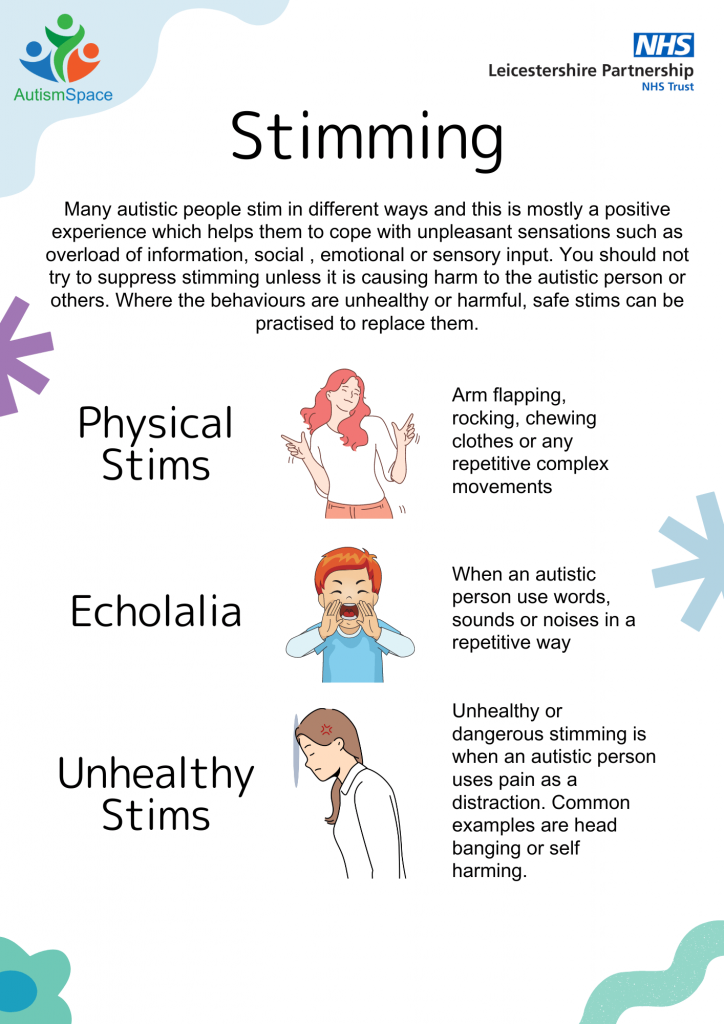Click here to view or download a transcript of this video
Stimming movements or vocal noises are often – but not always – repetitive.
Overt (obvious) stims include such things as
- arm or hand flapping
- repetitive finger movements
- repetitive facial movements
- dancing
- repetitive running
- pacing
- spinning
- rocking
- head banging
- tip toe walking
- stroking certain fabrics or materials
- repetition of words (echolalia)
- other noises made with the mouth/voice
Stimming can also involve the visual, auditory (hearing) and olfactory (sense of smell) systems – for example:
- looking at a lava lamp
- enjoying complex visual patterns
- repeatedly covering ears with hands to create intermittent noise
- making vocal stims in rooms that cause echos
- seeking out certain smells – such as essential oils or perfumes
Stimming can also include some less obvious (covert), often subconscious movements such as
- Wriggling toes inside shoes
- Twiddling hair
- Moving tongue or jaw
- Tapping fingers
- blinking
Why do autistic people stim?
For autistic people, excess energy can build up for a variety of possible reasons – such as sensory, social, emotional or information overload – or even boredom.
Autistic people can also find it hard to move from one activity to another. It’s often particularly difficult for them to stop when they are immersed in an activity. And it’s commonly hard for them to start an activity when they are in a state of low energy – which is often known as ‘autistic inertia’
When an autistic person is aware they need to stop or start an activity, it can create a sense of pent-up uncomfortable energy, often like a sense of claustrophobia or discomfort in one’s own skin.
Stimming is a way to release this excess, pent up energy – and bring about a feeling of calm, comfort and awareness in the body and mind. This is sometimes called ‘regulation’. Stimming can also block out unpleasant sensations such as overwhelm or anxiety.
In this way, stimming can improve mood, focus, information processing, decision making and motivation – and reduce sensory sensitivity and anxiety levels.
There is a similarity and cross-over between stimming, routine and repetition of activities
Autistic people can find it comforting and satisfying to do the same things over and over – such as watching re-runs of favourite TV shows, listening to songs on repeat or having a bedtime ritual where, for example all their cuddly toys or pillows need to be lined up just so. As with stimming, these behaviours can give a feeling of comfort and satisfaction – helping to calm the senses and emotions.
Often autistic people stim without thinking about it – but sometimes it is a conscious decision.
Sometimes they stim purely for enjoyment – such as a pleasurable visual, aural, movement or balance sensation.
Below is a video from Ambitious about Autism about stimming:
(Note: This video was not produced by Leicestershire Partnership NHS Trust and may contain adverts.)
Should you discourage others from, or try to suppress your stimming?
In an ideal world, everyone would understand, appreciate, and accept the need for stimming – and autistic people would not be judged negatively for it. However, in reality, the more obvious stims (such as larger body movements or vocalisations) can be perceived negatively – perhaps as strange, laughable, annoying or distracting.
Autistic people may have been shamed by others for stimming – or are at least aware this could be possible. So many supress or mask their stims in efforts to blend in with the majority and to feel safe.
Choosing when and where to stim can be helpful if this is something that concerns you. You may want to consider having a fidget toy in your pocket or under your desk. You may want to take yourself off to another room or leave early so that you can stim without the fear of judgement. If you are the parent or carer of an autistic person, it can be helpful to consider supporting them to have a safe space to stim.
Also consider educating others on the purpose and value of stimming.
Unless the stimming behaviour is harmful or causes serious disruption (eg prevents learning or completion of important tasks) you should not hold back from stimming or attempt to discourage it.
Stimming is actually one of the most valuable tools for helping autistic people cope in a world that to them is often overwhelming and stressful.
Suppression of stimming will likely lead to a build-up of uncomfortable energy and lead to overwhelm – which may then over time result in a meltdown/shutdown or contribute to poor mental health or burnout.
Many autistic people – especially those who are late diagnosed, may not realise that some of their behaviours are in fact stims. This is especially true for many of the more subtle stims.
It can be helpful to recognise that stimming is therapeutic and to experiment with different types of stims to see which are the most beneficial for you or your child.
It can also be helpful to practise noticing when you are feeling stuck, claustrophobic or that energy / emotions are building up – and to consciously engage in stimming when this happens.
If you are a parent or carer of an autistic person, you can support and encourage them to do this. Timely stimming can help to stave off negative emotions, meltdown, or shutdowns and can help increase ability to focus, process information and make decisions.
Is all stimming healthy?
A frequent question from parents of autistic children and teenagers is what to do about unhealthy stimming. Examples include head banging against walls/floor, finger biting, or even self-harming. Unfortunately, pain is the strongest distraction available to us (have you ever been to the dentist and dug your nails into the palm of your hand?). It blocks out all other sensations. Some autistic people at times choose pain as a way to cover and block out all other sensory inputs.
If you are a parent or carer you can look out for triggers or early warning signs and try to remove any stimulus causing overwhelm.
If you are the autistic person you can try to develop self-awareness of your triggers and early warning signs by looking for patterns. You may find it helpful to use an app like Molehill Mountain or How We Feel to track situations and emotions that lead to unhealthy stimming. Or you could journal your feelings in a book.
If the triggers are not something that can be easily removed (like school for instance) then learning to replace the unhealthy stim with a safe stim instead is a good way of dealing with this.
A few examples of safe stims to try which may be good replacements for pain seeking stims:
- Anything involving deep pressure – squeezing an object, pressing fingertips together, a bear hug.
- Very loud music – preferably something repetitive or with a heavy beat.
- Spinning or swinging on a swing – any type of strong movement (if you are supporting a child who is light enough, you can try picking them up and swinging them around).
- Taking a cold shower – or even just washing hands in cold water.
- Always having a sensory or chew toy on hand.
Sometimes stims are mistaken for tics. Whilst there is some similarity in that tics can follow a build up of an unpleasant sensation in the body – there is a difference in that tics are fast, repetitive muscle movements that result in sudden and difficult to control body jolts or sounds.
Click here for an article on Health for Teens about tics.
In Summary
Many autistic people stim in different ways, and this is mostly a positive experience which helps them to cope with unpleasant sensations such as overload of information, social, emotional, or sensory input. You should not try to suppress stimming unless it is causing harm to the autistic person or others. Where the behaviours are unhealthy or harmful, safe stims can be practised to replace them.
Click here to view or download this graphic as an accessible pdf





